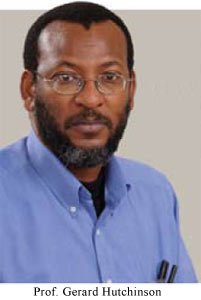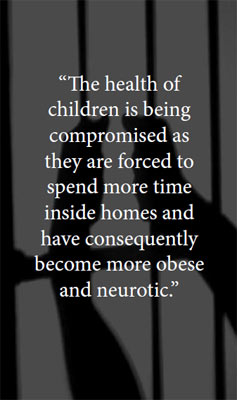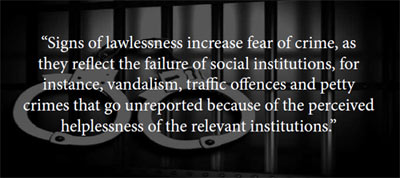 |
 |
 |
|
January 2012
|
By Professor Gerard Hutchinson
It is no surprise that crime is the most socially destabilizing feature of this part of the world. Criminal behaviour flourishes when the systems set up to organise, structure and protect society are unable to do so. This generates hopelessness and instability, simultaneously entrenching fear and encouraging crime by subtly changing the norms under which we operate. Then criminal behaviour is needed to cope with crime, hence more police killings and media superstars who can indulge the widespread fear with a by-any-means-necessary approach. This is validated precisely because there is no legitimacy from the traditional arms of the State. Widespread crime becomes a reflection of a pervasive political hostility. The gang world, living within its own codes of belonging, replaces the codes and norms of the wider society and becomes more attractive to the disenfranchised. This power is further enhanced by the weakness of the policing system, and the apparent impotence of the symbols of authority. With crime comes the fear of crime – compared to 76% of Americans and Canadians who feel secure walking in their neighbourhoods at night, this figure falls to 42% in Latin America according to a Gallup poll (59% in sub-Saharan Africa and 52% in the Soviet Union). Accordingly, crime and crime-related stories have become the most newsworthy. Daily, more than 50% of local and regional news items relate to crime and crime-related stories, including the legal and judicial correlates. In his 2007 book, “Governing through Crime: How the War on crime transformed American democracy and created a culture of fear,” Jonathan Simon found that this has led to an almost perverse attraction of crime control as the basis for executive power. It explains why some have called for a permanent state of emergency in Trinidad and Tobago. The media’s representation of crime and criminal behaviour may be contributing to the accelerated growth by simultaneously catering to the garish and brutal as well as desensitizing society to the lived reality of criminal behaviour. It creates a cinematic and ultimately caricatured representation of human suffering. It diminishes compassion but increases the need for protection. Power brokers in the society can then justify ever-increasing manipulation of control over lives through the use of more draconian measures of surveillance and punishment; hence the almost evangelical embrace of the death penalty through hanging as a cure. In a way, it is a demand for our institutions to act, for they appear to have become helpless. Signs of lawlessness also increase fear of crime as they reflect the failure of social institutions, for instance, vandalism, traffic offences and petty crimes that largely go unreported because of the ineffectual relevant institutions. So, does governing through crime make us more afraid or is it because we are more afraid we seek to be governed through crime? Baudrillard drew attention to the essential separation of meaning from reality and representation. In “The Transparency of Evil,” he argued for recognition of the need to look beyond the obvious meanings being applied to violent and destructive events. Are these events more material signs of our self hate? Are we destroying ourselves? Everybody thinks they are right and everybody is wrong so fingers are always pointed in one direction or the other; leaving no room for middle ground, or compromise or resolutions.
Poor fear conditioning in children is associated with adult criminal behaviour (Gao et al, 2010) and the American Academy of Pediatrics has issued a statement suggesting that exposure to media violence does lead to aggressive behaviour in children, desensitization to violence and a fear of being harmed. This leads us to focus on the functioning of our institutions to address the social ills that might contribute to this burgeoning violence and simultaneously a willingness to let executive power override our liberty. Education, health, law and social services have all failed to deliver on their promise despite increasing allocations from annual budgets. As one example, our External Examiner in Clinical Psychology always exclaims in astonishment that adolescents in our school system are for the first time being diagnosed with learning and other developmental disabilities in secondary school. They are usually only referred for assessment when they exhibit behavioural problems. Another factor is the pervasive distrust of our institutions. Only 20% of medical students believed that institutions functioned in their best interest and were not somehow rigged to benefit insiders or people who ‘knew’ somebody. This kind of environment encourages impulsive behaviour because of the association with fear, and distrust of the social mechanisms designed to protect. There is also a decreased threshold for enduring potentially stressful situations. Fear of crime has been associated with poorer health because of several mechanisms: less social activity leading to decreased social support, less outdoor activity leading to less physical exercise, increased levels of anxiety leading to decreased stress thresholds. Other negative health concomitants include heavier drinking, decreased resistance to pathogens and diminished psychological well-being and life satisfaction independent of personal achievements. The health of children is being compromised as they are forced to spend more time indoors and have consequently become more obese and neurotic. They have also been given enough incentive to stay inside with the proliferation of games and technological gadgets. Initiatives to decrease the fear of crime can improve health functioning, but the fear must first be acknowledged. There must also be an accompanying decline in criminal activity which in turn demands a reduction in the social ills that lead to increased criminal activity. It must also be established that the fear of crime is a separate issue from the occurrence of crime. They are both related though to the idea of consumption and material possession and acquisition as the ultimate ideal of modern life. People are afraid to lose the possessions that have come to define their social status. Road rage in response to minor accidents is a consequence of this phenomenon. Individuals also commit crimes to engage in the act of consumption without the equivalent investment of time or energy. They are not willing to work hard to acquire. The loss of a community ethos, that is, the rise of individualism, the attainment of self worth and psychological well-being through object accumulation and the loss of that self worth through object loss also affect both the phenomenology of crime and the associated fear. Even crimes of passion are related to social status with regard to being rejected and the inability to satisfy the social and economic demands of a romantic relationship – again related to the capacity of a particular kind of consumption (Baudrillard – The Consumer Society). Yuh Looking for Horn and No Money No Love are songs that have expressed this ethos for some time. This is a direct consequence of the use of GNP and GDP as a country’s measure of success, which has been questioned in recent years by many high profile economists. The loss of a community ethos is a factor in this process, as criminal behaviour is more easily beneficial in an atmosphere where there is a lack of community involvement, which in itself is a function of the fear of crime, hence the phenomenon of bystanders looking on and not intervening while crimes are perpetrated, or the reluctance of such witnesses to come forward when suspects have been apprehended.
The frequent experience of personal and institutional incivilities, causing a perceived loss of control, a continuum of minor crimes and personal harassment all contribute to an increased vulnerability and an increased fear of crime. It also contributes to a fracture of relationships between older and younger people since the latter are frequently seen as the purveyors of crime and the former as the victims. In multi ethnic societies, it can also serve to reinforce stereotypes and justify ethnic separatism. There is also a strong correlation between worklessness and both the fear of crime and the occurrence of crime. With high crime rates, it is clear that something should be done to address both, in other words, crime fighting cannot address only the occurrence of crime; it must also address the fear of crime. If the fear of crime is diminished, the law enforcement system could expect more active involvement of witnesses, increased reporting of criminal intent and a more actively involved citizenry. Simon concluded his book with a call for passive citizens to become engaged partners in the management of risk and the treatment of social ills. Only by coming together to produce security, can we free ourselves from a logic of domination by others, and from the fear that currently rules our everyday life. Initiatives such as urban greening, community education and facilitation and increased cohesive community activity can serve to mediate both the fear of crime and the occurrence of crime. Changes in the way the media report stories, such as following up on issues, diminishing sensationalism, and highlighting crime prevention efforts (like neighbourhood policing), would also contribute. It has been argued that crime and public health are coterminous, with the same factors contributing to both and therefore improvements in one would automatically improve the other. There must be a reconstruction of social relationships if there is to be a direct challenge to crime and the fear of its occurrence. The preoccupation with the body with an accompanying neglect of the mind is a further manifestation of this whirlwind of social competition masquerading as concern for health. Lifestyle choices informed by anxiety will always have the confounding effect of increasing the risk of chronic lifestyle related diseases because of the impact of stress. The life expectancy in Trinidad and Tobago for males is the third lowest in the Caribbean, above only Guyana and Haiti in spite of our oil and gas wealth. It is not related to homicide, because Jamaica and Belize, with comparable homicide rates, have higher life expectancies. The crisis of legitimacy that has facilitated both the growth of crime and its accompanying fear is also compromising personal health. Professor Gerard Hutchinson is the Head of Department, Clinical Medical Sciences, School of Medicine, Faculty of Medical Sciences, EWMSC, UWI. |


 The reality of criminal behaviour and particularly violent criminal behaviour has become the Caribbean’s most pressing social problem. Jamaica and Trinidad and Tobago are among the countries with highest murders per capita rate across the world, while St Kitts, St Lucia and Belize are reporting sharply increasing rates of homicide and violent behaviour.
The reality of criminal behaviour and particularly violent criminal behaviour has become the Caribbean’s most pressing social problem. Jamaica and Trinidad and Tobago are among the countries with highest murders per capita rate across the world, while St Kitts, St Lucia and Belize are reporting sharply increasing rates of homicide and violent behaviour.  Fear and anxiety seem rampant and are themselves a cause for a decreased threshold for violence even against ourselves. Rates of self harm have exponentially increased in the last decade in Trinidad, with cutting now a common and almost normal feature of adolescence in some areas. While suicide rates have declined, this is still high when compared with the rest of the Caribbean apart from Guyana, Suriname and Cuba. High rates of self harm are thought to reflect poor mental and cognitive health in a country; this may also be true of criminal behaviour.
Fear and anxiety seem rampant and are themselves a cause for a decreased threshold for violence even against ourselves. Rates of self harm have exponentially increased in the last decade in Trinidad, with cutting now a common and almost normal feature of adolescence in some areas. While suicide rates have declined, this is still high when compared with the rest of the Caribbean apart from Guyana, Suriname and Cuba. High rates of self harm are thought to reflect poor mental and cognitive health in a country; this may also be true of criminal behaviour.  Fear of crime may reflect a range of political and social anxieties, which in turn are linked to perceived vulnerability to victimization. These issues may influence how the fear becomes disproportionate to the actual risk. It appears that societies in transition are more vulnerable to these effects and social consequences.
Fear of crime may reflect a range of political and social anxieties, which in turn are linked to perceived vulnerability to victimization. These issues may influence how the fear becomes disproportionate to the actual risk. It appears that societies in transition are more vulnerable to these effects and social consequences.